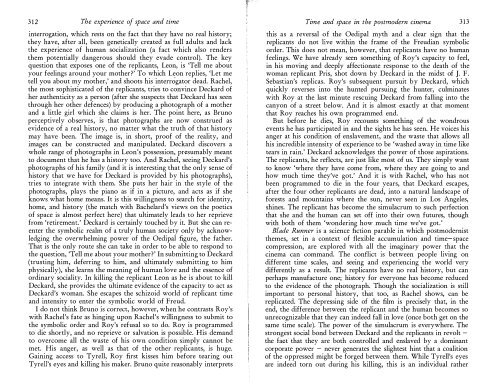The Condition of Postmodernity 13 - autonomous learning
The Condition of Postmodernity 13 - autonomous learning
The Condition of Postmodernity 13 - autonomous learning
Create successful ePaper yourself
Turn your PDF publications into a flip-book with our unique Google optimized e-Paper software.
312 <strong>The</strong> experience <strong>of</strong> space and timeinterrogation, which rests on the fact that they have no real history;they have, after all, been genetically created as full adults and lackthe experience <strong>of</strong> human socialization (a fact which also rendersthem potentially dangerous should they evade control). <strong>The</strong> keyquestion that exposes one <strong>of</strong> the replicants, Leon, is 'Tell me aboutyour feelings around your mother?' To which Leon replies, 'Let metell you about my mother,' and shoots his interrogator dead. Rachel,the most sophisticated <strong>of</strong> the replicants, tries to convince Deckard <strong>of</strong>her authenticity as a person (after she suspects that Deckard has seenthrough her other defences) by producing a photograph <strong>of</strong> a motherand a little girl which she claims is her. <strong>The</strong> point here, as Brunoperceptively observes, is that photographs are now construed asevidence <strong>of</strong> a real history, no matter what the truth <strong>of</strong> that historymay have been. <strong>The</strong> image is, in short, pro<strong>of</strong> <strong>of</strong> the reality, andimages can be constructed and manipulated. Deckard discovers awhole range <strong>of</strong> photographs in Leon's possession, presumably meantto document that he has a history too. And Rachel, seeing Deckard'sphotographs <strong>of</strong> his family (and it is interesting that the only sense <strong>of</strong>history that we have for Deckard is provided by his photographs),tries to integrate with them. She puts her hair in the style <strong>of</strong> thephotographs, plays the piano as if in a picture, and acts as if sheknows what home means. It is this willingness to search for identity,home, and history (the match with Bachelard's views on the poetics<strong>of</strong> space is almost perfect here) that ultimately leads to her reprievefrom 'retirement.' Deckard is certainly touched by it. But she can reenterthe symbolic realm <strong>of</strong> a truly human society only by acknowledgingthe overwhelming power <strong>of</strong> the Oedipal figure, the father.That is the only route she can take in order to be able to respond tothe question, 'Tell me about your mother?' In submitting to Deckard(trusting him, deferring to him, and ultimately submitting to himphysically), she learns the meaning <strong>of</strong> human love and the essence <strong>of</strong>ordinary sociality. In killing the replicant Leon as he is about to killDeckard, she provides the ultimate evidence <strong>of</strong> the capacity to act asDeckard's woman. She escapes the schizoid world <strong>of</strong> replicant timeand intensity to enter the symbolic world <strong>of</strong> Freud.I do not think Bruno is correct, however, when he contrasts Roy'swith Rachel's fate as hinging upon Rachel's willingness to submit tothe symbolic order and Roy's refusal so to do. Roy is programmedto die shortly, and no reprieve or salvation is possible. His demandto overcome all the waste <strong>of</strong> his own condition simply cannot bemet. His anger, as well as that <strong>of</strong> the other replicants, is huge.Gaining access to Tyrell, Roy first kisses him before tearing outTyrell's eyes and killing his maker. Bruno quite reasonably interpretsTime and space in the postmodern cinema 3<strong>13</strong>this as a reversal <strong>of</strong> the Oedipal myth and a clear sign that thereplicants do not live within the frame <strong>of</strong> the Freudian symbolicorder. This does not mean, however, that replicants have no humanfeelings. We have already seen something <strong>of</strong> Roy's capacity to feel,in his moving and deeply affectionate response to the death <strong>of</strong> thewoman replicant Pris, shot down by Deckard in the midst <strong>of</strong> J. F.Sebastian's replicas. Roy's subsequent pursuit by Deckard, whichquickly reverses into the hunted pursuing the hunter, culminateswith Roy at the last minute rescuing Deckard from falling into thecanyon <strong>of</strong> a street below. And it is almost exactly at that momentthat Roy reaches his own programmed end.But before he dies, Roy recounts something <strong>of</strong> the wondrousevents he has participated in and the sights he has seen. He voices hisanger at his condition <strong>of</strong> enslavement, and the waste that allows allhis incredible intensity <strong>of</strong> experience to be 'washed away in time liketears in rain.' Deckard acknowledges the power <strong>of</strong> those aspirations.<strong>The</strong> replicants, he reflects, are just like most <strong>of</strong> us. <strong>The</strong>y simply wantto know 'where they have come from, where they are going to andhow much time they've got.' And it is with Rachel, who has notbeen programmed to die in the four years, that Deckard escapes,after the four other replicants are dead, into a natural landscape <strong>of</strong>forests and mountains where the sun, never seen in Los Angeles,shines. <strong>The</strong> replicant has become the simulacrum to such perfectionthat she and the human can set <strong>of</strong>f into their own futures, thoughwith both <strong>of</strong> them 'wondering how much time we've got.'Blade Runner is a science fiction parable in which postmodernistthemes, set in a context <strong>of</strong> flexible accumulation and time-spacecompression, are explored with all the imaginary power that thecinema can command. <strong>The</strong> conflict is between people living ondifferent time scales, and seeing and experiencing the world verydifferently as a result. <strong>The</strong> replicants have no real history, but canperhaps manufacture one; history for everyone has become reducedto the evidence <strong>of</strong> the photograph. Though the socialization is stillimportant to personal history, that too, as Rachel shows, can bereplicated. <strong>The</strong> depressing side <strong>of</strong> the film is precisely that, in theend, the difference between the replicant and the human becomes sounrecognizable that they can indeed fall in love (once both get on thesame time scale). <strong>The</strong> power <strong>of</strong> the simulacrum is everywhere. <strong>The</strong>strongest social bond between Deckard and the replicants in revolt -the fact' that they are both controlled and enslaved by a dominantcorporate power - never generates the slightest hint that a coalition<strong>of</strong> the oppressed might be forged between them. While Tyrell's eyesare indeed torn out during his killing, this is an individual rather
















